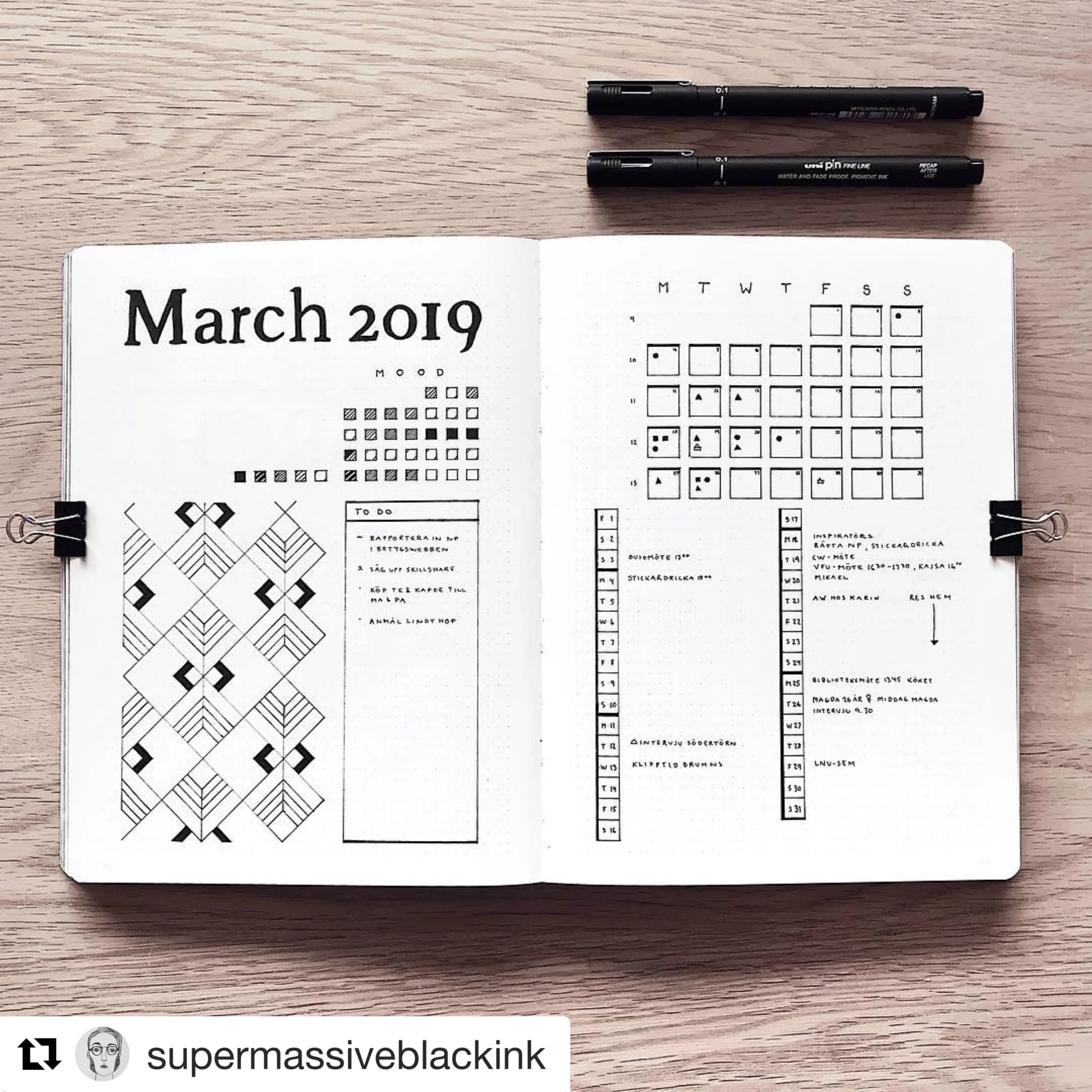The Monthly Spread Bullet Journal is an important part of organizing and planning in the bullet journaling world. It acts as an anchor for writing important events, tasks, responsibilities, and goals for the following month. Whether you’re a longtime bullet journal user or new to the method, knowing how to use the monthly spread will help you stay organized and improve your productivity.
We’ll go over all you need to know in this detailed guide to create and customize your monthly spread bullet journal to fit your specific needs and tastes.
1. Understanding the Monthly Spread:
It’s important to understand the basic structure and purpose of your monthly spread before getting too creative with it. A monthly spread usually consists of two facing pages: one for a calendar grid for the full month and the other for additional planning items like priorities, goals, and trackers. This design gives you an extensive summary of the entire month and leaves room for detailed planning.
2. Choosing a Layout:
The best part of designing a monthly spread is trying to figure out a layout that works for you and your aesthetic. There are lots of layout alternatives for you to explore, from complex layouts with decorative components and themed patterns to minimalist designs with simple calendar grids. Some common layout designs are as follows:
- Traditional Grid: A classic layout featuring a grid-style calendar with boxes for every day of the month.
- Vertical Layout: A vertical arrangement of calendar days, allowing for more space to write detailed notes and tasks.
- Horizontal Layout: A horizontal arrangement of calendar days, better for those who prefer a more linear approach to planning.
- Decorative Themes: Themes with graphics, stickers, tape, and other decorative items that are influenced by the seasons, holidays, nature, or personal interests.
3. Adding Functional Elements:
Once you’ve chosen a layout for your monthly spread, it’s time to add functional elements to enhance its usefulness and effectiveness. Consider adding the following elements into your monthly spread:
- Important Dates: To make sure you don’t miss any key events, mark birthdays, anniversaries, holidays, appointments, and other important dates on your calendar grid.
- Goals and Priorities: Prioritize and set monthly goals so that you can focus your attention on the things that are most important to you. Utilize the extra page in your spread to break down your goals into smaller goals and track how you progress over the course of the month.
- Habit Tracker: Make space in your monthly spread to record routines and habits that you wish to maintain or improve. To track daily routines like exercise, meditation, reading, drinking water, and more, make a grid or list style.
- Notes and Reflections: Make space to write down your ideas, notes, lists of gratitude, or special moments throughout the month. As ideas and observations come to mind, use this section to write them down. This can be used as a record of your progress and journey.
4. Customizing Your Monthly Spread:
The beauty of bullet journaling lies in its flexibility and customization options. Feel free to personalize your monthly spread to reflect your unique style, interests, and personality. Experiment with different colors, fonts, doodles, and embellishments to make your spread visually appealing and inspiring. Don’t be afraid to get creative and think outside the box—your monthly spread is a blank canvas waiting to be filled with your imagination.
5. Tips for Success:
As you begin creating and using your monthly spread bullet journal, keep the following tips in mind to maximize its effectiveness:
- Consistency is key: Set aside time at the beginning or end of each month to create your monthly spread and review your goals and priorities.
- Keep it simple: While it’s tempting to go all out with decorative elements and elaborate designs, remember that the primary purpose of your monthly spread is to help you stay organized and focused. Focus on functionality first, and add decorative elements sparingly.
- Regularly review and update: Take time to review your monthly spread throughout the month to ensure you’re staying on track with your goals and priorities. Make adjustments as needed, and celebrate your accomplishments along the way.
6. Themed Monthly Spreads:
Take your monthly spread to the next level by incorporating themed designs inspired by seasons, holidays, or personal interests. Themed spreads add a fun and festive touch to your journaling experience, making each month feel unique and special. Whether you’re celebrating the arrival of spring with floral motifs or getting into the holiday spirit with festive decorations, themed spreads allow you to infuse your personality into your planning.
7. Goal Setting and Tracking:
Use your monthly spread as a dedicated space for setting and tracking your goals. Begin each month by outlining your overarching goals and breaking them down into actionable steps. Then, use your monthly spread to track your progress and celebrate your achievements along the way. By visually mapping out your goals and progress, you’ll stay motivated and focused on what you want to accomplish.
8. Monthly Review and Reflection:
At the end of each month, take time to review and reflect on your accomplishments, challenges, and lessons learned. Use your monthly spread to jot down key insights, memorable moments, and areas for improvement. Reflecting on the past month allows you to gain clarity on your priorities and make adjustments for the month ahead. It’s also an opportunity to express gratitude for the experiences and opportunities that came your way.
9. Budget Planning and Expense Tracking:
Transform your monthly spread into a financial planning tool by incorporating budgeting and expense tracking elements. Create sections for income, expenses, savings goals, and debt repayment, allowing you to stay on top of your finances and make informed decisions about your money. Use color-coded categories and charts to visualize your spending habits and identify areas where you can save or cut back. With a comprehensive financial plan in place, you’ll have greater peace of mind and control over your financial future.
10. Personal Growth and Self-Care:
In addition to planning and productivity, prioritize your personal growth and self-care in your monthly spread. Dedicate space for self-reflection, gratitude practice, and self-care activities that nourish your mind, body, and soul. Whether it’s journaling prompts, inspirational quotes, or self-care challenges, infuse your monthly spread with elements that promote holistic well-being and fulfillment. By making self-care a priority, you’ll cultivate resilience, balance, and joy in your life.





